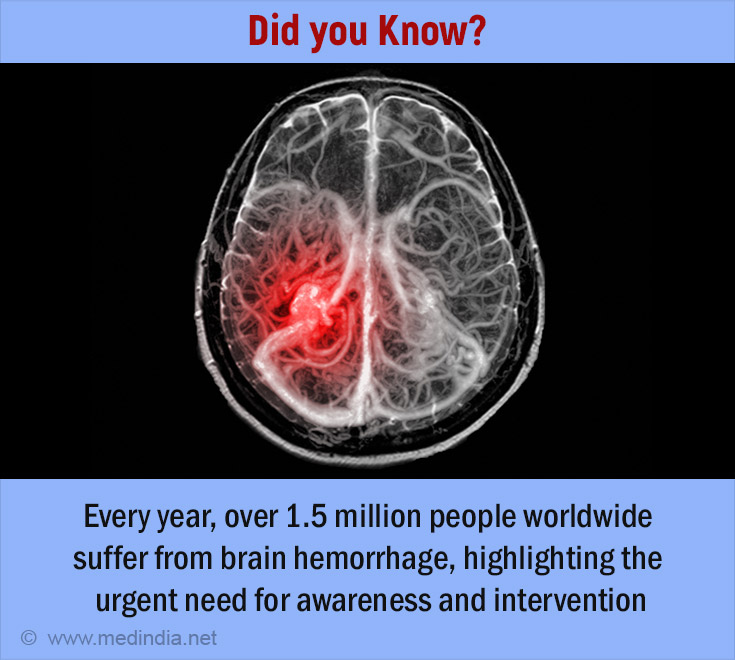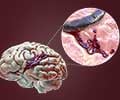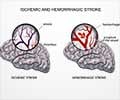- Intracranial Hemorrhage - (https://pubmed.ncbi.nlm.nih.gov/29262016/)
- Cerebral Hemorrhage: Pathophysiology, Treatment, and Future Directions - (https://pubmed.ncbi.nlm.nih.gov/35420918/)
- Essential Topics About the Imaging Diagnosis and Treatment of Hemorrhagic Stroke: A Comprehensive Review of the 2022 AHA Guidelines - (https://pubmed.ncbi.nlm.nih.gov/35870549/)
- Intracerebral hemorrhage: an update on diagnosis and treatment - (https://pubmed.ncbi.nlm.nih.gov/31188036/)
About
Brain hemorrhage, also known as intracranial hemorrhage (ICH), refers to a form of hemorrhagic stroke characterized by bleeding occurring within the skull and brain. This condition represents a critical medical emergency in which the rupture of arteries results in brain injury, potentially affecting adjacent structures such as the meninges (protective layers of the brain) and ventricles (cavities within the brain)(1✔ ✔Trusted Source
Intracranial Hemorrhage
Go to source).
Brain hemorrhage, a formidable neurological emergency, presents a multifaceted challenge in clinical practice. It encompasses a spectrum of conditions characterized by bleeding within or around the brain, each with its unique etiology, clinical presentation, and management strategies.
Did You Know?
Brain hemorrhage is a leading cause of disability worldwide.Intracerebral Hemorrhage (ICH)
Intracerebral hemorrhage, often abbreviated as ICH, is a form of brain hemorrhage marked by bleeding within the brain tissue itself. This condition typically arises due to the rupture of small blood vessels, leading to the accumulation of blood in the brain parenchyma. Intracerebral hemorrhage is associated with various risk factors such as hypertension, cerebral amyloid angiopathy, and trauma. It presents as a medical emergency with symptoms including severe headache, weakness, altered consciousness, and neurological deficits(2✔ ✔Trusted Source
Cerebral Hemorrhage: Pathophysiology, Treatment, and Future Directions
Go to source).
- Cause: Rupture of a blood vessel within the brain, often due to conditions such as hypertension, cerebral amyloid angiopathy, or arteriovenous malformations (AVMs).
- Symptoms: Sudden onset of severe headache, weakness on one side of the body, altered consciousness, speech difficulties, and
nausea and vomiting . - Treatment: Immediate medical attention is critical. Treatment may involve controlling blood pressure, surgical evacuation of the hematoma, and rehabilitation to address neurological deficits.
Subarachnoid Hemorrhage (SAH)
Subarachnoid hemorrhage, referred to as SAH, occurs when there is bleeding into the space between the arachnoid membrane and the pia mater, two of the protective layers surrounding the brain. The most common cause of SAH is the rupture of an intracranial aneurysm. It is characterized by a sudden, severe headache often described as "the worst headache of one's life," along with nausea, vomiting, neck stiffness, and altered mental status. SAH requires urgent medical attention and intervention to prevent complications such as vasospasm and rebleeding.
- Cause: Rupture of an aneurysm or arteriovenous malformation in the subarachnoid space surrounding the brain.
- Symptoms: Abrupt, severe headache ("thunderclap headache"), nausea, vomiting, neck stiffness, and altered mental status.
- Diagnosis: CT scan or lumbar puncture to detect blood in the cerebrospinal fluid (CSF).
- Treatment: Immediate management includes controlling blood pressure, surgical clipping or endovascular coiling of the aneurysm, and monitoring for complications like vasospasm(3✔ ✔Trusted Source
Essential Topics About the Imaging Diagnosis and Treatment of Hemorrhagic Stroke: A Comprehensive Review of the 2022 AHA Guidelines
Go to source).

Subdural Hematoma (SDH)
Subdural hematoma, known as SDH, is a type of brain hemorrhage characterized by the accumulation of blood between the dura mater (outermost layer of the meninges) and the arachnoid membrane. SDH typically occurs as a result of head trauma, leading to tearing of bridging veins. This condition can present acutely with symptoms such as headache, confusion, dizziness, and focal neurological deficits, or chronically with milder symptoms that develop over time. Treatment options include surgical evacuation for acute cases and monitoring for chronic cases.
- Cause: Traumatic injury leading to the accumulation of blood between the dura mater and arachnoid membrane.
- Symptoms: Headache, confusion, dizziness, focal neurological deficits, and seizures.
- Types: Acute subdural hematoma (rapid onset) and chronic subdural hematoma (develops over days to weeks).
- Treatment: Surgical evacuation for acute cases, while chronic cases may require monitoring or surgical drainage.
Epidural Hematoma (EDH)
Epidural hematoma, or EDH, is a type of brain hemorrhage characterized by bleeding between the skull and the dura mater. EDH most commonly occurs due to trauma resulting in arterial injury. It is characterized by a lucid interval following the initial loss of consciousness, followed by a rapid deterioration of neurological status. Symptoms include headache, vomiting, focal neurological deficits, and altered mental status. Emergency surgical intervention is necessary to evacuate thehematoma and relieve pressure on the brain.
- Cause: Trauma resulting in bleeding between the skull and dura mater, often due to arterial injury.
- Symptoms: Initial loss of consciousness followed by lucid interval and subsequent deterioration, headache, vomiting, and focal neurological deficits.
- Treatment: Emergency surgical evacuation to relieve pressure on the brain and prevent herniation.
Intraventricular Hemorrhage (IVH)
Intraventricular hemorrhage, abbreviated as IVH, involves bleeding into the brain's ventricular system, which produces cerebrospinal fluid (CSF). IVH can occur as a complication of other types of brain hemorrhage or may be associated with conditions such as prematurity in newborns. Symptoms include altered mental status, seizures, signs of increased intracranial pressure, and neurological deficits. Treatment focuses on controlling bleeding and addressing underlying causes to prevent complications like hydrocephalus.
- Cause: Bleeding into the brain's ventricular system, commonly associated with conditions like intracerebral hemorrhage or prematurity in newborns.
- Symptoms: Altered mental status, seizures, signs of increased intracranial pressure, and neurological deficits.
- Treatment: Management focuses on controlling bleeding, addressing underlying causes, and preventing complications like hydrocephalus(4✔ ✔Trusted Source
Intracerebral hemorrhage: an update on diagnosis and treatment
Go to source).
Summary of Brain Hemorrhage Types
| Type of Brain Hemorrhage | Cause | Symptoms | Treatment |
| Intracerebral Hemorrhage | Ruptured blood vessel within the brain | Severe headache, weakness, altered consciousness | Blood pressure control, surgical evacuation, rehabilitation |
| Subarachnoid Hemorrhage | Ruptured aneurysm or AVM in subarachnoid space | Thunderclap headache, nausea, vomiting, neck stiffness | Blood pressure control, aneurysm clipping/coiling, monitoring |
| Subdural Hematoma | Traumatic injury causing blood accumulation | Headache, confusion, neurological deficits | Surgical evacuation, monitoring |
| Epidural Hematoma | Trauma leading to bleeding between skull and dura mater | Loss of consciousness, lucid interval, headache | Emergency surgical evacuation |
| Intraventricular Hemorrhage | Bleeding into brain's ventricular system | Altered mental status, seizures, signs of increased pressure | Bleeding control, underlying cause management |
In conclusion, different types of brain hemorrhage require tailored approaches to diagnosis and treatment. Early recognition and intervention are crucial for optimizing outcomes and reducing the risk of complications associated with brain hemorrhage. Healthcare providers should remain vigilant for symptoms suggestive of brain hemorrhage and promptly initiate appropriate management strategies.
"Brain Hemorrhage: Act Fast, Save Lives"










